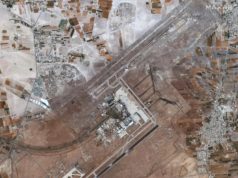Conventional wisdom in Washington and in European capitals is that the Syrian regime of Bashar al-Asad is doomed. The protests that have spread across the country since March of 2011 and claimed the lives of more than 6,000 people appear to be progressing by their own inertia. Secure in the assumption that “it’s only a matter of time,” Western countries have tagged on sanctions and other punitive measures that target Syria’s economy but have left out any discussion over the possibility of military intervention.
The assumption, however, that the regime’s days are numbered is seriously flawed. After all, U.S. and EU sanctions may have driven up food and energy prices, but it has failed to fundamentally alter the regime’s behavior. The Arab League even took the unprecedented step of kicking Syria out of the organization and dispatching a 165-member delegation of observers to monitor the situation inside the country. It was hoped that their presence would reduce the level of violence. But that mission has proven to be a failure, with the average daily death toll climbing to 50 since the monitors arrived in late December.
In fact, the case can be made that the international response to the Syrian uprising has emboldened the regime. On January 11, President Asad appeared in public for the first time since the uprisings began where he addressed a rally in Umayyad Square in Damascus and promised to defeat the “conspiracies” against his country. A day earlier he delivered a speech at Damascus University where he vowed to use an “iron fist” to put down the uprising, labeling the protesters as traitors and terrorists. Indeed, by continuing to blame the uprising on a foreign conspiracy and calling thousands of his countrymen “bandits, Zionists and al Qaeda,” the Syrian leader is demonstrating that he is as delusional as the late Libyan leader, Moammar Gaddafi. In past speeches, Assad paid lip service to the idea of government reform and offered some hollow concessions to the protesters but none were mentioned this time around. As the protests have continued, Asad has gauged what the outside world is willing to do — and more importantly, not do. The result is that he has become less willing to compromise.
The decision to foreswear military intervention bolsters the Assad regime at the expense of the opposition and American interests. Yet without foreign intervention, the unfortunate but most likely result will be a protracted and bitter, sectarian civil war. The smart money would be on the Assad regime maintaining power due to Iranian assistance and the continued delivery of fresh arms from Russia and Iran.
The greatest argument against military intervention remains the mantra, “Syria is not Libya.” And that is certainly true. In Libya’s case, Gaddafi was loathed both at home and abroad whereas Syria still enjoys the backing of Iran, Hezbollah, Russia, and to an extent, China. In Libya there were mass defections of soldiers and officers and an area of territory dominated and controlled by the opposition that could be used as a base to project power. In Syria, there are no swaths of territories firmly held by the forces of those defected, such as the Free Syrian Army. And there is no indication that Assad is failing to maintain his grip on the four pillars of Syrian power, namely, the unity of the Alawites, supremacy of the Ba’ath Party, supremacy of the al-Asad clan, and Alawite dominance over the military and intelligence apparatus. While all of this may be true, it is not a case for the White House to rest on its laurels.
The U.S. must prepare for the militarization of the conflict. If the Syrian civil war grows, regional actors will likely become involved, eager to sway the outcome. One need look no further than Syria’s neighbors in Lebanon and Iraq to gauge the probability of a regional conflict taking shape. In that scenario the U.S. will need to have a plan in place to set up “no-go”, “no-fly” and humanitarian zones. To prepare for this likelihood, Washington should form a contact group to work with international partners to share this cost and responsibility, while increasing the pressure on the Syrian regime.
Washington should also assist the various opposition groups in developing a strategy for coordinated civil resistance that includes providing them with intelligence, training, and advice. While a unified plan among the various opposition factions within Syria remains elusive, they have nevertheless made some uniform requests. Providing them with night-vision goggles, better communications equipment, and RPGs could help them fight beyond the current standstill and would perhaps be enough to free up towns that are under siege.
The anti-regime opposition began as a peaceful protest against a dictatorship. Bashar al-Asad’s brutal response — including the arrest and torture of regime opponents, the indiscriminate shelling of cities, and the cutoff of escape routes for civilian refugees to Turkey and Lebanon — has pushed the opposition to respond with force. By ignoring Asad’s escalation of violence against his people, the United States is helping to pave the way for more and greater depredations. The U.S. may choose not to intervene militarily, although the case for humanitarian intervention is manifest. But under no circumstances should Washington decline to provide the opposition the means to protect the people and, perhaps, oust a brutal dictator and puppet of Iran.





